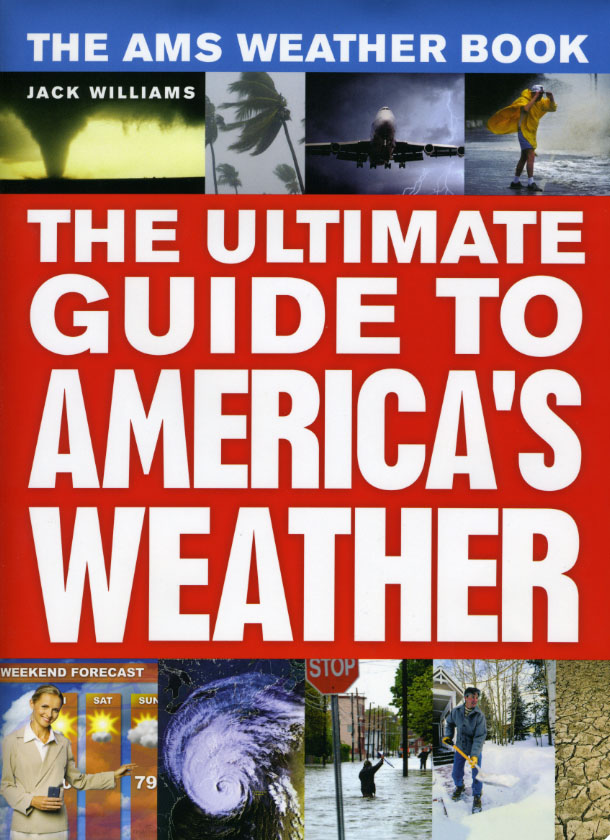Sources for Chapter 5
The books, Web sites, journal articles, and interviews listed on this page are sources of information other than facts and concepts found in most beginning college-level meteorology textbooks, which the author used or that could help readers better understand the concepts described. For more on various topics, including further reading and links to related Web sites, follow the links labeled “Explorations.” Links labeled “Outtakes” are to text from early drafts of the book that were dropped before publication.
In the notes below “the author” refers to Jack Williams, author of The AMS Weather Book.
Pages 98–100
- The story of Dana Tomlinson teaching science from the NOAA ship Ka’Imimoana is based on Tomlinson’s Web diary (no longer available online), a telephone interview with Tomlinson, and subsequent e-mail exchanges. Information on the AMS Maury Project that Tomlinson took part in is available online.
Page 100
Page 101
- The Michael Glantz profile is based on the author’s telephone interview with him and subsequent e-mail exchanges.
Page 102
- Photo caption information on why the clouds are not growing above the top of Mount Haleakala is from Kevin R. Kodama, of the NWS Honolulu Forecast Office, in answer to an e-mail query.
Page 103
- The development of precomputer meteorological models is discussed at length in Bob Sheets and Jack Williams, Hurricane Watch: Forecasting the Deadliest Storms on Earth (New York: Vintage, 2001), 11–14 and 22–40.
Page 105
- World-record atmospheric pressures from Miscellaneous Extremes map (PDF file) in P. F. Krause and K. L. Flood, Weather and Climate Extremes (Washington, DC: U.S. Army Corps of Engineers Topographic Engineering Center, 1997).
Page 107
- Polar air masses graphic: Radiosonde readings for January 24, 1989, from University of Wyoming, Department of Atmospheric Science’s Upper Air soundings data Web page.
- North American monsoon: David K. Adams and Andrew C. Comrie, “The North American Monsoon,” Bulletin of the American Meteorological Society 78 (October 1997): 2197–2213; NWS Climate Prediction Center, The North American Monsoon (PDF file), August 2004.
- Wet and dry season rainfall in Mumbai, India: The Weather Channel Web site’s monthly averages for Mumbai, India.
- Wet and dry season precipitation for Tucson, Arizona: The Weather Channel Web site’s monthly averages for Tucson, Arizona.
Page 109
- Bjerknes’s description of fronts is from Vilhelm Bjerknes, “Structure of the Atmosphere When Rain Is Falling,” Quarterly Journal of the Royal Meteorological Society 46 (1919): 119–140, quoted in Robert Marc Friedman, Appropriating the Weather: Vilhelm Bjerknes and the Construction of a Modern Meteorology (Ithaca, NY: Cornell University Press, 1989), 188.
Pages 109–112
- Jeffrey Rosenfeld, in his Eye of the Storm: Inside the World’s Deadliest Hurricanes, Tornadoes, and Blizzards (New York: Plenum Trade, 1999), 89–114, briefly tells the story of how Bjerknes and several others, including Carl-Gustaf Rossby, developed and improved the Norwegian model from World War I through World War II, including the role of jets streams.
- Outtake: A Meteorological Pioneer
Page 112
- A good, brief account of Wiley Post and his encounter with the jet stream and the problems the jet stream caused as airplanes began flying above 20,000 feet is in Gabrielle Walker, An Ocean of Air: Why the Wind Blows and Other Mysteries of the Atmosphere (New York: Houghton Mifflin Harcourt, 2008), 112–123.
Pages 113–114
- Information on atmospheric rivers from F. Martin Ralph, Paul J. Neiman, and Gary A. Wick, “Satellite and CALJET Aircraft Observations of Atmospheric Rivers over the Eastern North Pacific Ocean during the Winter of 1997/98,” The Monthly Weather Review 132 (July 2004): 1721–1745, and e-mail exchanges with F. Martin Ralph, of the NOAA.
- The image used for the graphic on page 114 is from a presentation (PowerPoint file) by Paul Neiman, of the NOAA.
Page 114–115
- The Gulf Stream: Richard Seager, “The Source of Europe’s Mild Climate,” American Scientist 94 (July–August 2006): 334–341.
- Oceanic and atmospheric heat transport: Kevin E. Trenberth and Julie M. Caron, “Estimates of Meridional Atmosphere and Ocean Heat Transports,” Journal of Climate 14 (August 15, 2001): 3433–3443.
Pages 116–118
- El Niño and profile of Gerald Bell: Based on the sources given in Explorations: The El Niño–Southern Oscillation and an interview with Gerald Bell in his office at the NWS Climate Prediction Center in Camp Springs, Maryland, with subsequent e-mail exchanges.
Page 119
- El Niño in Antarctica: Primarily drawn from the author’s story for USA Today, based on a satellite telephone press conference with Paul Mayewski shortly after the party reached the South Pole in early January 2003 and a follow-up e-mail exchange with Mayewski for The AMS Weather Book, as well as a report on El Niño and Antarctica, from the Scientific Committee on Antarctic Research Web site.
- Explorations: The 1957–58 International Geophysical Year
Pages 120–122
- University Corporation for Atmospheric Research’s Persistent Patterns that Shape Weather and Climate Variability—A Glossary
- Links to information about the various patterns:
- Arctic Oscillation: National Geographic graphic (PDF file); NOAA’s Climate Indicators: Arctic Oscillation Web page
- Pacific-North American Pattern: Texas A&M University Geography Department’s Pacific/North American Web page
- Antarctic Oscillation: New Zealand National Institute of Water & Atmospheric Research’s Southern Annular Mode and New Zealand Climate Web page
- Atlantic Multidecadal Oscillation: NOAA Atlantic Meteorological and Oceanographic Lab’s Atlantic Multidecadal Oscillation FAQ page

